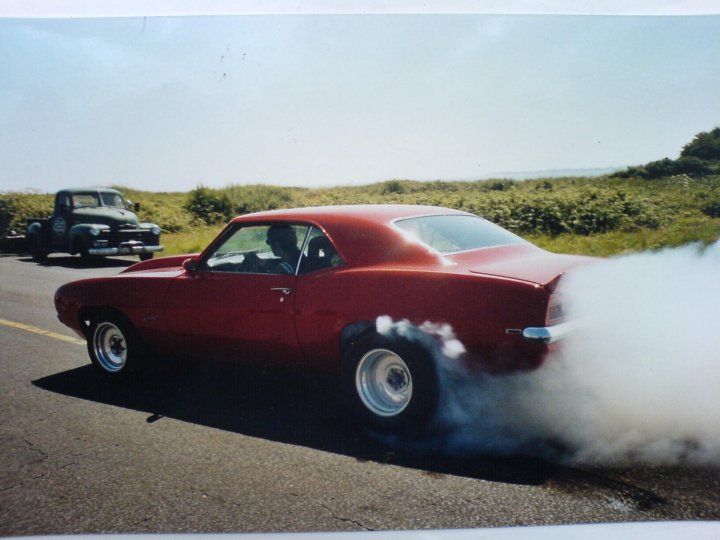| Two British friends of mine, below, didn't have to wait patiently like many women in Chris Lezote's book – they've been driving muscle cars since their twenties. UK motoring journalist Sarah Bradley says: "My 1969 Plymouth Road Runner, with its 383 cu in V8 is big, loud and in-your-face, and its elegant yet muscle-bound styling is sheer perfection." Jenny Griesel above, in her 1969 Chevy Camaro, says of driving muscle cars: “It’s different and cool. A big thing is the sound, it’s great when a V8 has just started and tickin’ over, oh yeah, and speed, that power - awesome.” Jenny enjoys a good burn-out – you can hardly see her Plymouth Cuda, below: Or entertaining the crowd in her Pontiac Formula 400, below. This Superbirds shoot for Classic & Sport Car will be treasured in my memory forever. I have to admit I was happy to let the owner perform this burn-out. But I did get to drive one the yellow one at 103mph down a private desert road. Zowie. | Chris Lezotte interviewed 88 muscle-mad ladies living around the American mid-west for her book Power Under Her Foot (Women Enthusiasts of Muscle Cars). Chris has worked as a copy writer and art director on Buick account, and lives in Ann Arbor, Michigan where I spent four extremely enjoyable years. I didn’t think muscle cars were my thing until I visited the extremely generous owner of an impressive collection just outside Palm Springs. I was there for a feature on the Plymouth Road Runner Superbird for Classic & Sports Car magazine with snapper Andrew Yeadon. As the wonderful chap handed me key after key to compare his Mach 1 Mustang, 383 ‘Cuda Convertible and Charger R/T with Police Interceptor package (as featured in the Bullitt car chase), before we even got to the sublime Superbird, I heard the roars and rumbles, felt the power and fell under the spell. The voices of the female owners in this book speak of joy freedom, power and empowerment. When men talk about their cars, they tend to reel off the numbers, eager to talk about the horsepower, the tyres and the shocks. These women talk about relationships, and how their car makes them feel. Chris takes her title from a 1968 Plymouth Satellite owner who said: “When I’m in my car I feel free, no stress and so much power under my foot, I can’t get enough of it.” There’s often a wistfulness, because most had to wait until their 50s – some until their 70s – to get behind the wheel, for many reasons Chris sets out to explore. The evocative reminiscences of their teenage days take the reader back to the golden era of cruising and racing on Detroit’s Woodward Avenue, where engineers from the Big Three auto manufacturers often rolled up to give hot rodders a sneak peek of their next cars, to get their reaction and maybe learn a few tips from the street. Girls who got to borrow a car from a brother or boyfriend were lucky. Most simply watched or rode along. Cindy who remembers a Mustang she coveted as a teen: “I wanted to buy it so bad, but I wouldn’t even presume that that would have been appropriate.” Jean, now the proud owner of a 1964 ½ Mustang, used to cut pictures out of magazines and paste them into a scrapbook. Adrienne, who now owns a Plymouth Barracuda says: “They told us you’re not supposed to be in it [the scene] girls aren’t supposed to interested in cars and engines.” I found the voices of these women compelling, appearing as quotes throughout the books, or as picture captions of proud owner and car. Each quote tells a story, some joyous, but many tinted with blue. These women did what was expected of them. They ran homes, worked as teachers, therapists and real estate agents and drove kids around in minivans. But once the kids could look after themselves, and they got a bit of money, they realised their dream. Or there was Helen from Sioux City Iowa, who was discouraged from getting a 2003 red Mustang convertible by her controlling husband. Once her divorce came through, she not only bought the car, but had the hood decorated with flames and the slogan “Super Bitch”. Now I’ve been a bit naughty here. I made up all those names because I found it hard to feel emotionally involved reading about a 48-year-old massage therapist, a 65-year-old retired interior decorator, or a 55-year-old CPA. (What is a CPA?). Some of the ladies Chris interviewed preferred to remain anonymous, but I feel an alias would have helped readers identify with them, and get to know them as they are clearly quoted in several different chapters. The book has its roots a university thesis and feels like it. There’s a lot of methodology, repetition and proof points. Chris observes that these middle-aged gas-guzzler-owning ladies from the mid west tend to be socially conservative (N.S.) She also asserts that the advertising industry had a machiavellian strategy to push women into family cars “as a means to construct women’s driving experience as less than their male counterparts” and keep muscle cars for men. Working in the advertising and marketing world as Chris did and I still do, I’m surprised she believes those mad man had any agenda other than flogging cars. Personally I believe society pushes people into roles - advertising only reflects and reinforces the social norms. As now, the wonderfully patronising ads Chris includes in the pages try to make female buyers feel better about owning that minivan. The Aerostar “can haul kids to school in the morning and turn around and tow a two-ton boat to the lake at night”. Yeah, right. Or AMC’s ad proclaims “She doesn’t mind the Pacer Wagon’s unique wide design makes it look a little different. That’s the way a woman with her own style likes to look.” (The Pacer became the wrong kind of icon as the car in which Wayne and his crew get their heads down to appreciate Bohemian Rhapsody in Wayne's World.) In a lot of cases, owning a car has improved the social life of the women Chris spoke to. Margie (not her name) a retired teacher, never drove her husband’s 1994 Z/28 Camaro while he was alive, but found that driving it helped her adjust to life without him and have fun, often inviting friends for a ride. She says: “I just feel so good, especially on these beautiful nights to be out with this car.” Others enjoy the social side of attending events and local meets. Kids think Gran is cool if she picks them up in a muscle car. Some have met first or second husbands through the scene, or feel the shared enthusiasm makes their marriage stronger. Susan is thrilled her loving husband has restored a Road Runner for her. The final chapter concludes: “Ownership of a muscle car, the women collectively argue, provides the opportunity for a different, more exhilarating driving experience. It encourages female motorists to try new things, participate in racing and track days, develop new skills, take challenging road trips and test their limits. It helps to change perceptions of a woman driver from passive to passionate.” The book aims to fill a gap in the automotive record, which concentrates on men. It does that, and makes a powerful case that given the opportunity, women get a real kick out of owning a muscle car. To me, and my car-crazy friends, that comes as no surprise. A bigger question, which needs continuing scrutiny is why it would be surprising. Owner of a 1969 Plymouth Roadrunner, UK motoring journalist Sarah Bradley says: “I both love and loathe the fact that – even in today's supposedly more enlightened times – people still do a double-take when they see a woman behind the wheel." It would also have been interesting to talk to those women who attend club meetings with their husband but find he’s always at the wheel. Or the women who lust after a Shelby Mustang, a sports car, an M-series BMW or anything regarded as a ‘boys’ car’ but still feel it would somehow be wrong, or too self-indulgent, or who don’t want heads to turn. Society has moved on, but in terms of the car (and the TV remote) women are still not equal. |
|
0 Comments
|
Woman Driver
This blog is by a woman driver, for everyone to read Archives
December 2019
Categories
All
|






 RSS Feed
RSS Feed
